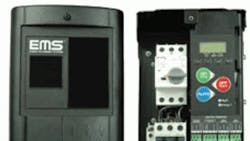Highly Integrated Motor Starters Assist in Center’s Pursuit of LEED Certification
In 2009, the City of Portland, Ore., broke ground for the Resource Access Center (RAC), a facility providing vital resources, shelter, and housing-placement services to homeless individuals and couples.
In pursuit of Platinum certification under the U.S. Green Building Council's Leadership in Energy and Environmental Design (LEED) green-building rating system, project manager Steve Young of controls and mechanical-design contractor American Heating specified measurement of the power consumption of each HVAC motor.
Typically, the power consumption of HVAC motors is measured by adding a power meter in series with each motor-starter device. For the RAC, Young suggested using the Energy Management Starter (EMS) from Cerus Industrial.
Designed for easy setup and operation, EMS is a highly integrated motor starter supporting building-automation networking with optional power metering and BACnet communication. It combines modules traditionally installed separately and wired together. With EMS installed at each motor, a building-automation system (BAS) gets power-consumption data for individual units, which enables better control and more accurate verification of energy consumption than with systems that measure only the power used by entire systems. EMS supports 1-percent American National Standards Institute-grade metering with pulse or analog output via the network interface and kilowatt and kilowatt-hour data available on an integrated liquid-crystal display. The starter supports proof-of-flow verification, which can detect belt loss and alert a BAS of problems with a HVAC unit.
"I loved not having to combine a starter and meter," Young said. "This saved us both space and money. We estimate that using the Cerus starters saved in the range of 50 percent of the cost of connecting to the motors, compared to traditional networked motor-starter installations."
The HVAC engineer laid out the RAC building-management-system (BMS) network first, choosing Trane controllers, which communicate via a LonWorks network. To interface the EMS and network, the EMS native master-slave/token-passing interface was converted to Internet Protocol with PolarSoft routers. Using the network, the BMS can instruct the motor starters to start and stop the motors and open and close associated mechanical dampers. The BMS also can gather information on the operational status and power measurements of each motor. When necessary, the BMS can put the starter in fireman's-override or emergency-shutdown mode. Motor status, starter-mode (hand/off/auto) overload settings, alarms, and fault indications are listed on the BMS operator’s console. EMS delivers its information to the BMS just as a typical variable-frequency drive or power meter would.
The RAC BMS interacts with 100 to 150 control points associated with the energy-monitoring system, another 200 to 300 control and monitoring points associated with the rest of the HVAC system, and additional points for other system-monitoring functions (e.g., lighting).
"The EMS was easy to integrate with the BMS," Young said. "We didn't need to make any alterations to our design or the drawings."
Even with the inclusion of the routers, American Heating found using the EMS to be significantly cheaper than building the system from separate components.
For Design Solutions author guidelines, call Scott Arnold, executive editor, at 216-931-9980, or write to him at [email protected].
